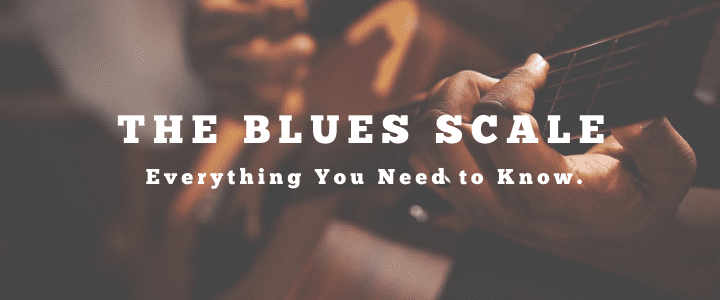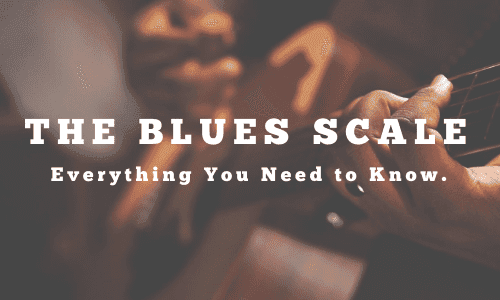
Learning the blues scale on guitar is something of a rite of passage for every guitarist. If you’re a beginner with reasonable dexterity and you’re serious about learning, you’ll find the blues scale to be extremely useful.
For intermediate guitarists, this scale is essential, but it’s also important to understand that scales are merely the alphabet of the blues language. It’s important to go beyond that and play real blues melodies as well, so you can start to better understand the style.
In this article, we’ll talk about the technique for how to play the blues scale on guitar, as well as some more advanced theory on how to apply it to real music.
[cta_split_test id=”BST-Guitar-Shortcode”]
How Do You Play Blues Scale on Guitar?
When you think of the blues, you might think of sad, slow music. But the blues can be fast and happy too. The blues scale is a great way to add some bluesy feel to your guitar playing, no matter what style you’re into – and here are some general tips:
- The blues scale is made up of 6 notes: the root note, flat 3rd, 4th, flat 5th, 5th and flat 7th.
- To play a blues scale in any key, you just have to start on the root note of the key you’re in and play those six notes in order. So, if you’re in the key of C, you would start on C and play C-Eb-F-Gb-G-Bb.
- Once you’ve memorized the pattern of notes for a few different keys, try improvising with them. Y
- ou can use the blues scale to solo over any 12 bar blues progression. Just find the root note of the chord being played in each bar, and start your solo on that note. For example, if you’re playing a 12 bar blues in C, you would use a C Blues Scale over all of the chords.
- The great thing about improvising with the blues scale is that there are endless possibilities. You can use it to play single notes or bend them to create long sustains sounds. You can experiment with different rhythms and techniques.
- Once you’ve got the hang of it, you can start to add your own personal flavor to your playing.
So go ahead and give the blues scale for guitar a try – your guitar playing will thank you for it!
Ready to become a better guitar player? It’s time to sign up for guitar lessons. You’ll learn everything you need to know about this fun, groovy style of playing, plus basic skills like what you see in the video below:
https://www.youtube.com/watch?v=1tKEkV7bB1E
What is the Blues Scale on Guitar?
The blues scale is one of the most essential scales for any guitar player to learn. It is a versatile scale that can be used in a variety of musical styles, and it sounds great both when played solo and when used as a backing for other instruments.
In its simplest form, the blues scale is simply a pentatonic scale. That might sound complicated, so let’s break down the theory.
Look at a piano if you have one, or look up an image of piano keys. Take a look at the black keys on the piano. They naturally fall into the pentatonic scale pattern. If you want to hear the pentatonic scale in the easiest way, just play anything you want on the black keys only.
The gaps between the groups of black keys show you something very important about the scale. Some of the notes are farther apart than others. This is because there are two types of “intervals” (or, spaces between notes) in the pentatonic scale. There are whole steps and minor thirds.
The whole step is made up of two half-steps. This is also equal to two frets on the guitar. The minor third is made up of three half-steps, which is equal to three frets on the guitar.
Whole steps and minor thirds are also referred to as “steps” and “skips.” Being aware of this pattern of steps and skips is the most important aspect of learning the blues scale.
Practice with the Pentatonic Scale
Let’s put the theory we’ve just learned into practice. The main resting or finishing note of a key is called the “root.”
As an example, we’ll look at the key of A minor. In the key of A minor you have the notes A – C – D – E – G. Those would be all natural notes (with no sharps or flats) and all white keys on a piano.
In any key you make a pentatonic scale in, you start with the root and go up a minor third (three half steps), then a whole step, then another whole step, then one more minor third, then one last whole step.
So in the key of A minor, the interval pattern from the root is:
(A) Skip (C) Step (D) Step (E) Skip (G) Step (A)
The same interval pattern would apply to any key, so even if the notes change, the sound of the scale will be similar. In other words, the interval structure is what determines most of the mood of a scale.
When you go to learn this on the guitar, the main thing you will learn to do is memorize “boxes” or patterns of whole steps and minor thirds that go across the strings.
We will talk about these more in the next section, but realize that it is an incredibly important and fundamental exercise to master at least one pentatonic box that you can use for playing songs.
Is a Blues Scale and a Pentatonic Scale the Same Thing?
The main difference between the blues scale and the pentatonic is the addition of one note. In the whole step between the third and fourth notes, you will play the note that falls between the third and fourth notes.
For example, in A minor, you’ll add an Eb in between D and E. So the interval pattern for the blues scale in the key of A minor would look like:
A (Skip) C (Whole Step) D (Half Step) Eb (Half Step) E (Skip) G (Whole Step) A
The reason this extra note is present is because it has a special place in a lot of blues melodies. It’s important to mention that it’s not enough just to have the extra note in the scale. The way you use it to create the blues sound is to play it in blues licks.
The best way to understand this is to learn the scale, and then play songs that use it so you can see the way it gets applied.
Playing the notes of the blues scale in totally random ways does not produce a “bluesy” sound; only playing the scale in the way it shows up in the traditional canon of songs will get you to the right place as a blues guitar player.
RELATED: 5 Easy Blues Guitar Licks
How Do You Turn a Pentatonic Scale Into a Blues Scale?
The blues scale is a minor pentatonic scale with an added flat 5th degree, or blue note. The flattened 5th degree gives the blues scale a distinctive sound that is often associated with the blues genre of music. This note usually falls on the 3rd string when played in the key of E, and can be played as either an open string or as the 2nd fret on the 3rd string.
To turn a pentatonic scale into a blues scale, simply add the flat 5th degree to create a 6-note scale. For example, in the key of E, the notes in a pentatonic scale are E, F#, G, B, and C#. To turn this into a blues scale, we simply add the flat 5th degree, which would be Ab (A flatsharp). Doing so gives us the notes E, F#, G, A flat sharp (Ab), B, C#.
The formula for turning any pentatonic scale into a blues scale is simple: just add a flattened 5th degree to create a 6-note blues scale. For example, in the key of A minor pentatonic, the notes are A, C, D, E flat (Eb), and G. To turn this into a blues scale, we simply add the flattened 5th degree which would be G sharp (G#). Therefore, the full blues scale in the key of A would be A, C, D ,E flat (Eb), G sharp (G#), and A. You can use this same formula to turn any minor pentatonic into a blues scale.
Basic Blues Scales on Guitar in Common Keys
When you start out learning the blues scale on guitar, you will want to learn the scale in the most common keys that it’s played in. Let’s start with the E blues scale.
E Blues Scale
This scale is usually considered the easiest to start with because it uses open strings and gives your fingers more time to adjust to changes.
In tablature, it will look like this.
If you want to play in most of the keys of the blues though, you need to learn the scale in a position that doesn’t use any open strings…
A Blues Scale
The thing that is so nice about the guitar is this: once you know this shape, all you have to do is move it around to the key you want to play in!
Here is what the A blues scale looks like in tablature.
Here are charts and tabs for two more of the most common keys. Give them a try and see if you can transfer the shape just by finding the root/starting note on your thick E string.
G Blues Scale
C Blues Scale
Practicing the Blues Scale on Guitar
Practice these scales in a way that inspires you. There are plenty of fun ways to master the blues scale on guitar, and you should choose the ones that inspire you the most.
Remember: motivation comes from action! Here are a few ideas to get you started.
- Repeat the A minor blues scale from the lowest note to the highest note, and then back down until you can remember the notes in order without looking at a tab or diagram.
- Switch between reading the diagram and then trying to remember, to see where your memory has gaps.
- Play one note at a time in the scale, along with a metronome at 60 BPM.
- Try to remember the finger pattern while playing with your eyes closed. Open your eyes to look only if you get lost.
- Pick a random song and try to place the scale shape you learned on the root note.
- You can try different notes until you find the root by ear, or look up the key of the song and place the scale box on that root.
How to Learn Blues Scales on Guitar: A Few Helpful Tips
The blues scale is a great way to add some flavor to your guitar playing. With its minor tonality and easy-to-remember pattern, the blues scale is a useful tool for any guitarist. Here are a few tips to help you learn blues scales on guitar.
Start by Memorizing the Scale Pattern
One of the best ways to learn any new scale is to memorize the pattern. The blues scale pattern is especially easy to remember, as it only contains six notes. Once you have the pattern memorized, you can practice it in any key. This will come in handy when you’re improvising or writing your own songs.
Practice the Scale in Different Keys
As mentioned above, once you have the blues scale pattern memorized, you can practice it in any key. This is a great way to get comfortable with the scale and expand your guitar playing abilities. By practicing in different keys, you’ll be able to use the scale all over the fretboard. This will make soloing and improvisation much easier.
Experiment with Note duration and Dynamics
Once you have the blues scale down, it’s time to start experimenting with note duration and dynamics. Try playing each note in the scale for different lengths of time. You can also experiment with different volume levels (dynamics). These two factors can have a big impact on the overall sound of the scale. So don’t be afraid to experiment!
Jam With Other Musicians
Now that you know how to play blues scales on guitar, it’s time to put your new skills into action! One of the best ways to do this is by Jamming with other musicians. When jamming with others, it’s important to listen carefully and let the music “speak” to you. In other words, don’t force anything – let your improvisation flow naturally from what you’re hearing from the other musicians around you.
Learn the Blues Scale on Guitar Today!
The blues scale is an essential tool for any guitar player looking to create their own solos and licks. By learning how to construct and play the blues scale on guitar, you’ll open up a whole world of new possibilities for your playing. So get out there and start jamming!
Knowing the blues scale is like knowing the alphabet, and life is a lot better when you can spell! This scale gets used with specific licks and phrases that define the blues sound, and having a teacher to help you see the connection between the scale and the music can be very helpful.
If you would like to find someone to help you take your blues skills a step further, look for a guitar teacher at TakeLessons. A local or online teacher will help you stay motivated as you progress, and give you more fun ways to practice all you’ve learned!
 Post Author: Jonathan B.
Post Author: Jonathan B.Jonathan B. teaches blues guitar, bass, and more in State College, PA. Jonathan is a Temple University, Music Theory graduate and YouTube celebrity with thousands of subscribers. Learn more about Jonathan here!
Jessica Dais
